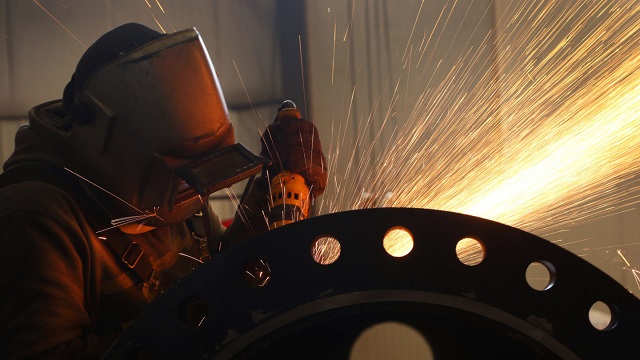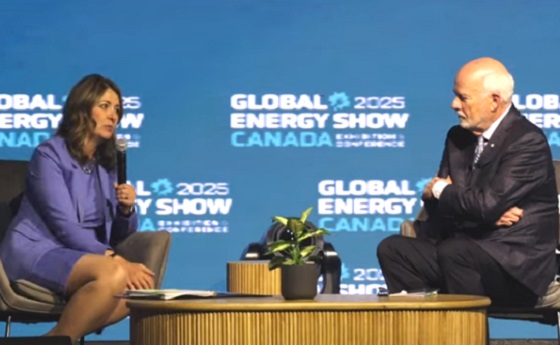Canadian Energy Centre
New national campaign aims to solve worker shortage in Canada’s energy sector

Donovan Doll works on a pipe at the CMR Fabricators Ltd. in Penhold, Alberta. Canadian Energy Centre photo by Dave Chidley
From the Canadian Energy Centre
By Will Gibson
Enserva launches new portal to train workers and provide long-term employment opportunities
Canadian energy services association Enserva has launched its solution to solve a worker shortage of more than 3,000 jobs, including labourers, drivers and tradespeople.
Having spent the better part of two decades working in the world of non-profit groups and think tanks, Enserva CEO Gurpreet Lail was taken aback after hearing about the sector’s labour struggles when she joined in 2021.
“The perception outside the industry was much different,” says Lail. “This has been an ongoing challenge for a long time and our members decided to do something about it.”
The result is a national campaign featuring the new Working Energy Portal, a sector-specific website with comprehensive job listings by the group’s 200-plus member companies and organizations.
“This is an industry-wide challenge and we’ve found an industry solution,” Lail says.
“We lost a lot of people during COVID and the downturn in energy prices and we’re now seeing employers fighting for labour regardless of the sector, be it energy or hospitality or technology,” she says.
“In addition to these factors, our sector also has to address this ridiculous idea that Canadian energy is a dying industry. That’s simply not the case. The world is going to need our energy for a very long time, and we need talented people to help us innovate and produce it responsibly.”

Enserva is hoping to connect those looking for jobs with companies that need positions filled and create a long-term solution to the shortage.
But the portal is more than a job board. It will also serve as a training hub to provide Canadians with the right certifications, courses and a pathway to rewarding careers.
“A lot of this is about educating people about what they might need so they can be successful in the industry, such as getting the right training and certificates,” says Lail.
“Many prospective employers are willing to help prospective employees in order to address their needs for skilled workers. For example, if you have a clean Class 5 driver’s license, some employers who need Class 1 drivers will pay for that training.”
She says that as the energy industry continues to transform to include a mix of oil and gas and renewable sources, it needs to fill current and emerging positions in practices like artificial intelligence, robotics, geothermal energy and environmental sustainability.
Enserva members helped create the portal in part because traditional job-search platforms didn’t always attract the right candidates or missed job seekers with real potential.
“Companies were using websites such as Indeed or LinkedIn but were finding it difficult to get the right candidates. They’d often get more than 1,000 resumes and maybe five to 10 were suitable for interview. It takes a lot of time to sift through those,” Lail says.
“We are supporting our members to create or increase awareness of their companies, and the jobs available. This way promising candidates will not miss a great opportunity and will have opportunities to learn more about energy companies.”
Enserva aims to push into new areas and communities to engage with prospective job seekers.
“We are reaching out to non-traditional areas to showcase the reality that you can have a long-term and rewarding career in this sector if you are a woman, Indigenous or come from a newer community in Canada,” Lail says.
“In addition to this outreach, we are continuing to recruit in traditional areas, such as young people entering the workforce and attracting former energy workers back into the sector.”
Canadian Energy Centre
Cross-Canada economic benefits of the proposed Northern Gateway Pipeline project

From the Canadian Energy Centre
Billions in government revenue and thousands of jobs across provinces
Announced in 2006, the Northern Gateway project would have built twin pipelines between Bruderheim, Alta. and a marine terminal at Kitimat, B.C.
One pipeline would export 525,000 barrels per day of heavy oil from Alberta to tidewater markets. The other would import 193,000 barrels per day of condensate to Alberta to dilute heavy oil for pipeline transportation.
The project would have generated significant economic benefits across Canada.

The following projections are drawn from the report Public Interest Benefits of the Northern Gateway Project (Wright Mansell Research Ltd., July 2012), which was submitted as reply evidence during the regulatory process.
Financial figures have been adjusted to 2025 dollars using the Bank of Canada’s Inflation Calculator, with $1.00 in 2012 equivalent to $1.34 in 2025.
Total Government Revenue by Region
Between 2019 and 2048, a period encompassing both construction and operations, the Northern Gateway project was projected to generate the following total government revenues by region (direct, indirect and induced):

British Columbia
- Provincial government revenue: $11.5 billion
- Federal government revenue: $8.9 billion
- Total: $20.4 billion
Alberta
- Provincial government revenue: $49.4 billion
- Federal government revenue: $41.5 billion
- Total: $90.9 billion
Ontario
- Provincial government revenue: $1.7 billion
- Federal government revenue: $2.7 billion
- Total: $4.4 billion
Quebec
- Provincial government revenue: $746 million
- Federal government revenue: $541 million
- Total: $1.29 billion
Saskatchewan
- Provincial government revenue: $6.9 billion
- Federal government revenue: $4.4 billion
- Total: $11.3 billion
Other
- Provincial government revenue: $1.9 billion
- Federal government revenue: $1.4 billion
- Total: $3.3 billion
Canada
- Provincial government revenue: $72.1 billion
- Federal government revenue: $59.4 billion
- Total: $131.7 billion
Annual Government Revenue by Region
Over the period 2019 and 2048, the Northern Gateway project was projected to generate the following annual government revenues by region (direct, indirect and induced):

British Columbia
- Provincial government revenue: $340 million
- Federal government revenue: $261 million
- Total: $601 million per year
Alberta
- Provincial government revenue: $1.5 billion
- Federal government revenue: $1.2 billion
- Total: $2.7 billion per year
Ontario
- Provincial government revenue: $51 million
- Federal government revenue: $79 million
- Total: $130 million per year
Quebec
- Provincial government revenue: $21 million
- Federal government revenue: $16 million
- Total: $37 million per year
Saskatchewan
- Provincial government revenue: $204 million
- Federal government revenue: $129 million
- Total: $333 million per year
Other
- Provincial government revenue: $58 million
- Federal government revenue: $40 million
- Total: $98 million per year
Canada
- Provincial government revenue: $2.1 billion
- Federal government revenue: $1.7 billion
- Total: $3.8 billion per year
Employment by Region
Over the period 2019 to 2048, the Northern Gateway Pipeline was projected to generate the following direct, indirect and induced full-time equivalent (FTE) jobs by region:

British Columbia
- Annual average: 7,736
- Total over the period: 224,344
Alberta
- Annual average: 11,798
- Total over the period: 342,142
Ontario
- Annual average: 3,061
- Total over the period: 88,769
Quebec
- Annual average: 1,003
- Total over the period: 29,087
Saskatchewan
- Annual average: 2,127
- Total over the period: 61,683
Other
- Annual average: 953
- Total over the period: 27,637
Canada
- Annual average: 26,678
- Total over the period: 773,662
Business
Natural gas pipeline ownership spreads across 36 First Nations in B.C.

Chief David Jimmie is president of Stonlasec8 and Chief of Squiala First Nation in B.C. He also chairs the Western Indigenous Pipeline Group. Photo courtesy Western Indigenous Pipeline Group
From the Canadian Energy Centre
Stonlasec8 agreement is Canada’s first federal Indigenous loan guarantee
The first federally backed Indigenous loan guarantee paves the way for increased prosperity for 36 First Nations communities in British Columbia.
In May, Canada Development Investment Corporation (CDEV) announced a $400 million backstop for the consortium to jointly purchase 12.5 per cent ownership of Enbridge’s Westcoast natural gas pipeline system for $712 million.
In the works for two years, the deal redefines long-standing relationships around a pipeline that has been in operation for generations.
“For 65 years, there’s never been an opportunity or a conversation about participating in an asset that’s come through the territory,” said Chief David Jimmie of the Squiala First Nation near Vancouver, B.C.
“We now have an opportunity to have our Nation’s voices heard directly when we have concerns and our partners are willing to listen.”
Jimmie chairs the Stonlasec8 Indigenous Alliance, which represents the communities buying into the Enbridge system.
The name Stonlasec8 reflects the different regions represented in the agreement, he said.
The Westcoast pipeline stretches more than 2,900 kilometres from northeast B.C. near the Alberta border to the Canada-U.S. border near Bellingham, Wash., running through the middle of the province.

It delivers up to 3.6 billion cubic feet per day of natural gas throughout B.C. and the Lower Mainland, Alberta and the U.S. Pacific Northwest.
“While we see the benefits back to communities, we are still reminded of our responsibility to the land, air and water so it is important to think of reinvestment opportunities in alternative energy sources and how we can offset the carbon footprint,” Jimmie said.
He also chairs the Western Indigenous Pipeline Group (WIPG), a coalition of First Nations communities working in partnership with Pembina Pipeline to secure an ownership stake in the newly expanded Trans Mountain pipeline system.
There is overlap between the communities in the two groups, he said.
CDEV vice-president Sébastien Labelle said provincial models such as the Alberta Indigenous Opportunities Corporation (AIOC) and Ontario’s Indigenous Opportunities Financing Program helped bring the federal government’s version of the loan guarantee to life.
“It’s not a new idea. Alberta started it before us, and Ontario,” Labelle said.
“We hired some of the same advisors AIOC hired because we want to make sure we are aligned with the market. We didn’t want to start something completely new.”
Broadly, Jimmie said the Stonlasec8 agreement will provide sustained funding for investments like housing, infrastructure, environmental stewardship and cultural preservation. But it’s up to the individual communities how to spend the ongoing proceeds.
The long-term cash injections from owning equity stakes of major projects can provide benefits that traditional funding agreements with the federal government do not, he said.
Labelle said the goal is to ensure Indigenous communities benefit from projects on their traditional territories.
“There’s a lot of intangible, indirect things that I think are hugely important from an economic perspective,” he said.
“You are improving the relationship with pipeline companies, you are improving social license to do projects like this.”
Jimmie stressed the impact the collaborative atmosphere of the negotiations had on the success of the Stonlasec8 agreement.
“It takes true collaboration to reach a successful partnership, which doesn’t always happen. And from the Nation representation, the sophistication of the group was one of the best I’ve ever worked with.”
-

 Business1 day ago
Business1 day agoRFK Jr. planning new restrictions on drug advertising: report
-

 Education2 days ago
Education2 days agoStudents can’t use AI to cheat on standardized tests
-

 espionage16 hours ago
espionage16 hours agoFrom Sidewinder to P.E.I.: Are Canada’s Political Elites Benefiting from Beijing’s Real Estate Reach?
-

 conflict2 days ago
conflict2 days agoTrump dismisses US intelligence that Iran wasn’t pursuing nuclear bomb before Israeli attack
-

 Censorship Industrial Complex2 days ago
Censorship Industrial Complex2 days agoJordan Peterson reveals DEI ‘expert’ serving as his ‘re-education coach’ for opposing LGBT agenda
-

 Alberta1 day ago
Alberta1 day agoUnified message for Ottawa: Premier Danielle Smith and Premier Scott Moe call for change to federal policies
-

 Business1 day ago
Business1 day agoCanada’s critical minerals are key to negotiating with Trump
-

 International1 day ago
International1 day agoJudiciary explores accountability options over Biden decline ‘coverup’






